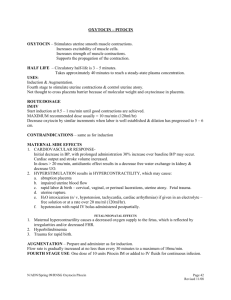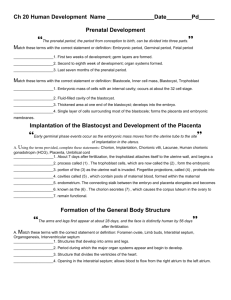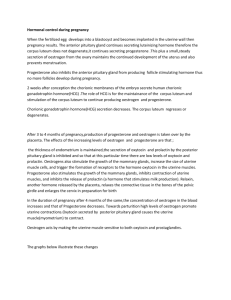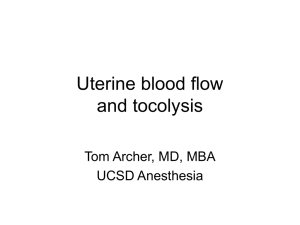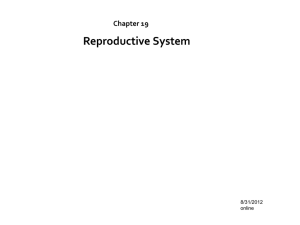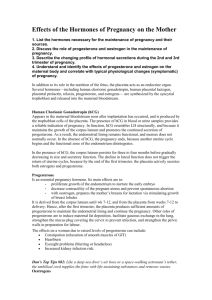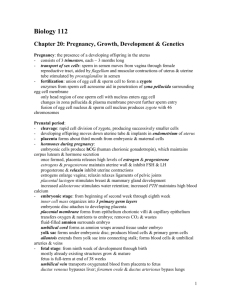PowerPoint - Honors Human Physiology
advertisement
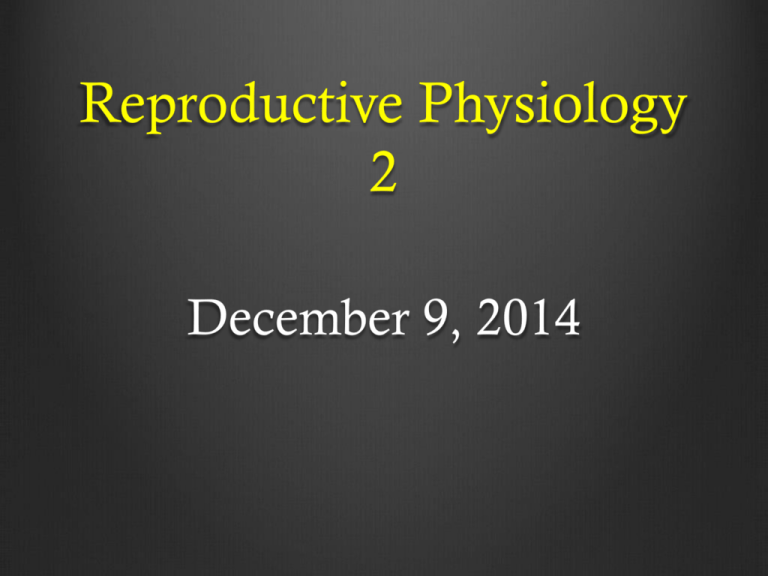
Reproductive Physiology 2 December 9, 2014 Contraceptives • The most commonly-used chemical contraceptive is a combination of estrogen and progesterone. • Providing relatively low levels of these hormones causes an inhibition of GnRH, LH and FSH secretion. • FSH levels are tonically maintained at such a low level that follicles never mature into antral (Graafian) follicles, so ovulation never occurs. Combined Contraceptives • Most combination chemical contraceptives come in packages of 28 pills, with 21 “active” pills (containing hormones) and 7 placebo pills. Taking the placebo pills allows a menstrual period to occur, as hormones are withdrawn. • However, other contraceptive strategies are also used. For example, some women prefer an extended-cycle regimen, which entails taking 12 weeks of active pills followed by one week of inactive pills, to limit the number of menstrual periods per year. • In addition to delivering combined contraceptives orally, the hormones can be delivered through a patch on the skin or a flexible ring inserted into the vagina (NuvaRing®). Low-Dose Progesterone Contraceptives • Progesterone-only contraceptives can be taken orally, through subdermal implants (e.g., Norplant® ) or through an intrauterine system (e.g., Mirena®). • Progesterone-only contraceptives are not as effective in preventing ovulation as combined (estrogen + progesterone) contraceptives. • The main efficacy of the progesterone-only contraceptives may be related to maintaining the cervical mucus in a state that is inhospitable for sperm. Over time, the progesterone-only contraceptives may also affect the uterine lining, such that implantation of a fertilized ovum is less likely. • The half-life of progesterone is relatively short. Hence, progesterone-only pills must be taken within a 3-hour time window each day. High-Dose Progesterone Contraceptives • Depo-Provera is a long-acting progesterone analog that is effective for three months. • Depo-Provera is injected intramuscularly, and the dose of progesterone is high enough to prevent ovulation (by inhibiting GnRH, LH, and FSH secretion), to cause the cervical mucus to be inhospitable to sperm, and to make the endometrium unreceptive for implantation of a blastocyst. Hence, DepoProvera is a highly effective contraceptive. • However, since the drug inhibits estradiol secretion, the benefits of estradiol are lost. For example, women who take DepoProvera for an extended period may be at risk for osteoporosis. • Depo-Provera also is effective in reducing GnRH, LH, and FSH secretion in men, and thus the drug lowers testosterone levels and renders the male sterile (chemical castration). High-Dose Progesterone Contraceptives • High Doses of Progesterone (Levonorgestrel, “Plan B”) can be used as an “emergency contraceptive”. • The sudden increase in hormone results in a rapid dropoff of LH and FSH secretion, which prevents ovulation if it has not yet occurred • The high levels of progesterone change secretions in the Fallopian tubes, generating an environment that makes fertilization less likely. • If fertilization has already occurred, emergency contraceptives are ineffective. Other Contraceptives • Insertion of a copper intrauterine device (IUD) is more effective than high doses of steroids as an emergency contraceptive. • Copper acts as a natural spermicide, and the presence of the foreign substance in the reproductive tract induces the release of prostaglandins and white blood cells in the uterine and tubal fluids that inhibits fertilization. • Copper IUDs are some of the most effective contraceptives available, and do not alter the normal hormonal cycles. • Adverse effects include heavy menstrual periods and a small risk of damage to the uterine lining or infections. • Note that some reports indicate that copper IUDs, particularly when used for emergency contraception, act by preventing implantation instead of inhibiting fertilization. Transport of Gametes and Fertilization • At ovulation, the ovum that is released from the ovary is surrounded by a layer of specialized granulosa cells that are attached to the zona pellucida (the glycoprotein membrane surrounding the oocyte). • These granulosa cells form the corona radiata,whose main function is to provide vital proteins to the oocyte. Transport of Gametes and Fertilization • The fimbriae of the fallopian tubes pick-up the ovum, and movements of the cilia and contractions of smooth muscle in the fallopian tubes propel the ovum towards the uterus. Transport of Gametes and Fertilization • An average fertile male deposits 150-600 million sperm into the uterus during ejaculation, but only 50-100 of those sperm reach the ampulla of the fallopian tube. • The sperm get to the ampulla very quickly, within ~5 minutes of ejaculation. Forceful contractions of the uterus, cervix, and fallopian tubes propel the sperm into the upper reproductive tract during female orgasm. Prostaglandins in the seminal plasma may induce further contractile activity. Capacitation of Sperm • Before a sperm can fertilize the oocyte, it must undergo capacitation. Capacitation involves the destabilization of the acrosomal sperm head membrane allowing greater binding between sperm and oocyte. • This process is not well understood, but requires exposure of the sperm to a variety of substances in the female reproductive tract. One of these proteins is fertilization promoting peptide, which is produced by the prostate gland. • Sperm are first exposed to fertilization promoting peptide during ejaculation, but the concentration is too high in the seminal fluid to permit capacitation. Capacitation occurs only after the seminal fluid is diluted by the secretions in the female reproductive tract. In addition, secretion of sterol-binding albumin, lipoproteins, proteolytic and glycosidasic enzymes such as heparin by the uterus aids in the capacitation process. Fertilization Fertilization Movement of the Zygote to the Uterus • After the cell mass enters the uterus, it floats freely in the lumen of the uterus and transforms into a blastocyst: a ball-like structure with a fluid-filled inner cavity. • Blastocyst formation begins about 5 days after fertilization, when a fluid-filled cavity opens up in the morula. • The morula’s cells differentiate into two types: an inner cell mass growing on the interior of the blastocoel (the fluid-filled cavity) and trophoblast cells growing on the exterior. • The trophoblast cells will develop into a variety of supporting structures, including the amnion, the yolk sac, and the fetal portion of the placenta. The inner cell mass will develop into the embryo. Secretions by the Blastocyst and Placenta • Probably the most important chemical factor produced by the blastocyst is human chorionic gonadotropin (hCG), which is closely related to LH. • The secretion of hCG is critically important in maintaining the corpus luteum, which secretes progesterone. Progesterone is necessary to maintain the uterine endometrium. Without the support of progesterone, the uterine lining degenerates and the pregnancy is terminated. • Besides rescuing the corpus luteum, hCG is a growth factor that promotes trophoblast growth and placental development. hCG levels are high in the area where the trophoblast faces the endometrium. hCG may have a role in the adhesion of the trophoblast to the epithelia of the endometrium, and it also has protease activity. Clinical Note: Progesterone Antagonists • Since progesterone is critically important in maintaining the uterine endometrium, a progesterone antagonist will result in a shedding of the endometrial lining, and an induced abortion if a woman is pregnant. • RU486 is a progesterone antagonist. Implantation Entails Four Steps • The first stage of implantation of the zygote in the uterus is hatching, or degeneration of the zona pellucida. • This occurs 6-7 days after ovulation. • Lytic factors released by the endometrium play a key role in hatching. • However, the blastocyst also plays a role, as hatching does not occur when an unfertilized ovum is placed in the uterus. • Plasminogen release from the endometrium (which is converted to Plasmin through TPA produced by the blastocyst) may be key for hatching, since plasmin has been shown to lyse the zona pellucida in experimental studies. Implantation Entails Four Steps • The earliest contact between the blastocyst wall and the endometrial epithelium is a loose connection called apposition. Apposition occurs at a site where the zona pellucida is ruptured and where it is possible for the cell membranes of the trophoblast to make direct contact with the cell membranes of the endometrium. • Since hatching is required before apposition occurs, it seems likely that apposition entails interactions between glycoproteins on the surface of trophoblast and endometrial cells. Implantation Entails Four Steps • After apposition, microvilli in the membranes of trophoblast cells form rigid attachments to the endometrial cells through ligandreceptor interactions. This process is called adhesion. Implantation Entails Four Steps • After adhesion occurs, the trophoblast cells rapidly proliferate and differentiate into two layers. Long protrusions from the outer layer extend among uterine epithelial cells. • The protrusions secrete chemicals such as tumor necrosis factor that dissociate the endometrial cells (break cell-cell adhesions), so the protrusions can invade deep into the endometrium. • Uterine stromal cells near the protrusions become transformed into decidua cells. The decidua cells initially provide nutrients to the blastocyst until the formation of the placenta. Clinical Note: Ectopic Pregnancies • Ectopic pregnancies occur when the zygote implants outside of the uterus. Most ectopic pregnancies occur in the Fallopian tube (so-called tubal pregnancies), but implantation can also occur in the cervix, ovaries, and abdomen. • Due to the invasive nature of the blastocyst, an ectopic pregnancy can result in severe bleeding as the structure invades the wall of the structure it is attaching to. • Women with ectopic pregnancies often seek treatment due to severe abdominal pain. • If an ectopic pregnancy is discovered, it can be resolved surgically or by giving methotrexate. Methotrexate inhibits the metabolism of folic acid. Since folic acid is necessary for the production of new cells, for DNA synthesis, and for RNA synthesis, methotrexate inhibits the rapid growth of cells that is necessary for development of the zygote. Physiology of the Placenta • Within a few days, the blastocyst penetrates through the uterine wall. Fluid filled spaces develop in the trophoblast (lacuna), which become continuous with maternal blood vessels. Over time, the blood-filled cavities in the trophoblast merge to form intravillous spaces. Physiology of the Placenta • As the fetus matures, it develops blood vessels that form treelike structures called “villi” that protrude into the intravillous spaces (which are filled with maternal blood). This arrangement provides ample surface area for exchange of materials between the maternal and fetal plasma. Physiology of the Placenta • In addition to providing a conduit for nutrient exchange between fetus and mother, the placenta secretes a number of hormones that are critical for maintenance of the pregnancy, including hCG, inhibins, estrogens, and progesins. • Under the influence of hCG, the corpus luteum grows to about twice its initial size by a month or so after pregnancy begins. • Its continued secretion of estrogens and progesterone maintains the decidual nature of the uterine endometrium, which is necessary for the early development of the fetus. • If the corpus luteum is removed before approximately the 7th week of pregnancy, spontaneous abortion occurs. Physiology of the Placenta • After that 7th-12th week, the placenta secretes sufficient quantities of progesterone and estrogens to maintain pregnancy for the remainder of the gestation period. • The corpus luteum involutes after the 13th-17th week of pregnancy. • hCG also stimulates the primordial male testis to produce testosterone, which is critical for development of male genitalia and descent of the testicles. Physiological Responses —Estrogens 1. Enlargement of the mother’s uterus. 2. Enlargement of the mother’s breasts and growth of the breast ductal structure. 3. Enlargement of the mother’s external genitalia. 4. Relaxation of the pelvic ligaments of the mother, so the sacroiliac joints become relatively limber and the symphysis pubis becomes elastic. These changes allow easier passage of the fetus through the birth canal. 5. Stimulating the rate of cell reproduction in the early embryo. 6. Increasing the number of oxytocin receptors on uterine smooth muscle cells 7. A wide variety of physiological changes described later. Physiological Responses —Progestins 1. Changes in the uterus that are needed to sustain a pregnancy. 2. Reduced contractility of the uterus, reducing the risk of a spontaneous abortion. 3. Changes in the cellular development of the fetus. 4. Along with estrogens, changes in the breast to prepare for lactation. 5. Physiological changes described below. Chorionic Somatomammotropin (HCS) 1. Also called human placental lactogen. 2. Closely resembles growth hormone in structure. 3. Modifies the metabolic state of the mother during pregnancy to facilitate the energy supply of the fetus. 4. Does not enter the fetal circulation, and only affects the mother. Chorionic Somatomammotropin (HCS) Effects of HCS include: • ↓ Maternal insulin sensitivity leading to an increase in maternal blood glucose levels. • ↓ Maternal glucose utilization, which helps ensure adequate fetal nutrition • ↑ Lipolysis with the release of free fatty acids. Hence, free fatty acids become available for the mother as fuel, so that relatively more glucose can be utilized by the fetus. Also, ketones formed from free fatty acids can cross the placenta and be used by the fetus. Physiological Changes During Pregnancy Increases in Blood Volume: • Maternal blood volume may increase by as much as 45% near term in single pregnancies and up to 75% to 100% in twin or triplet pregnancies. • Renal perfusion increases as there is a dilation of the renal arteries. • In addition, aldosterone secretion increases, which augments renal reabsorption of salt and water. Physiological Changes During Pregnancy Increases in Cardiac Output: • Increases in preload resulting from an expanded blood volume result in an increase in cardiac output (~45% at term). • Blood pressure decreases because of decreased peripheral resistance. • Vasodilation is prominent in the kidneys (~40% increase in blood flow), uterus (which receives 15% of cardiac output during pregnancy), skin, and breasts. Physiological Changes During Pregnancy Increases in Alveolar Ventilation: • Very high progesterone levels are believed to play a key role in increasing alveolar ventilation in pregnant women. • The shape of the diaphragm changes, resulting in a decrease in residual volume. • The brainstem respiratory pattern generator is excited, which is the primary reason alveolar ventilation increases. As a result, PCO2 in arterioles decreases from 40 to 32 mmHg, resulting in a slight respiratory alkalosis, which is corrected by the kidney. Preeclampsia and Eclampsia • Preeclampsia is a serious and not uncommon (5% of pregnancies) pregnancy complication. • The condition is characterized by high blood pressure, as well as damage to an organ system. • Preeclampsia is often characterized by excess salt and water retention by the mother’s kidneys and by weight gain and development of edema in the mother. Preeclampsia and Eclampsia • In addition, there is impaired function of the vascular endothelium and arterial spasm occurs in many parts of the mother’s body, most significantly in the kidneys, brain, and liver. • Both the renal blood flow and the glomerular filtration rate are decreased, which is exactly opposite to the changes that occur in the normal pregnant woman. • The renal effects also include thickened glomerular tufts that contain a protein deposit in the basement membranes. Preeclampsia and Eclampsia • The exact cause of preeclampsia is unknown, but the condition starts with a failure to provide adequate blood flow to the placenta. • The placenta fails to implant normally into the uterine wall, such that normal pattern of placental blood flow is not established. • Hypoxia of the placenta results in the release of a variety of chemical toxins such as tumor necrosis factor-α and interleukin-6, which may result in endothelial cell changes throughout the mother’s circulatory system. Preeclampsia and Eclampsia • The only definitive treatment for preeclampsia is removal of the fetus and placenta from the mother. • Depending on the age of the fetus and the severity of the condition, the mother may be treated with antihypertensive drugs until the fetus is viable, at which time delivery occurs through induced labor or Caesarian section. Preeclampsia and Eclampsia • Eclampsia is a more serious form of preeclampsia. • Severe hypertension eventually causes the breakdown of the blood-brain barrier, vascular dilation, and leakage of considerable fluid into the brain (cerebral edema). • As a result, severe headache and convulsions can occur. • Similar pathology can occur in the retina, leading to visual problems and potential blindness. • Untreated eclampsia will often result in death. Parturition: Triggers • Parturition is likely initiated by signals from the placenta or fetus. • Progesterone levels remain constant near the end of gestation, whereas estrogen levels continue to increase. It has been argued that the estrogenprogesterone ratio in the blood contributes to initiating labor. • The fetus releases increasing amounts of a variety of hormones including oxytocin, cortisol, and prostaglandins near the time of labor, which also may serve as triggers. Parturition: Triggers • A number of lines of evidence argue that prostaglandins can initiate labor: Prostaglandins (PGF2α and PGE2) evoke myometrial contractions at any stage of gestation. Arachidonic acid (precursor of prostaglandins) instilled into the amniotic cavity causes the uterus to contract and to expel its contents. Aspirin, which inhibits the enzyme cyclooxygenase, reduces the formation of PGF2α and PGE2, thus inhibiting labor and prolonging gestation. Parturition: Maintenance • Prostaglandins The uterus, the placenta, and the fetal membranes synthesize and release prostaglandins. Prostaglandins from the uterine decidual cells, particularly PGF2α and PGE2, act by a paracrine mechanism on uterine smooth muscle cells. Oxytocin stimulates uterine decidual cells to increase their PGF2α synthesis. Arachidonic acid is present in very high concentrations in the fetal membranes near term Parturition: Maintenance • Prostaglandins Have Three Effects: Strongly stimulate the contraction of uterine smooth muscle cells. PGF2α potentiates the contractions induced by oxytocin by promoting formation of gap junctions between uterine smooth muscle cells; estradiol also increases the number of gap junctions. Cause softening, dilatation, and thinning (effacement) of the cervix, which occurs early during labor Parturition: Maintenance • Oxytocin: Estrogen levels during pregnancy cause an expression of oxytocin receptors on the surface of uterine smooth muscle cells. Once labor is initiated, maternal oxytocin is released in bursts, and the frequency of these bursts increases as labor progresses. The primary stimulus for the release of maternal oxytocin appears to be distention of the cervix; this effect is known as the Ferguson reflex. Parturition: Maintenance • Oxytocin: Oxytocin is an important stimulator of uterine smooth muscle contraction late in labor. Oxytocin may also indirectly induce uterine contractions by virtue of its ability to stimulate prostaglandin release. Parturition: Maintenance • Once labor is initiated, several positive feedback loops involving prostaglandins and oxytocin help to sustain it: Uterine contractions stimulate prostaglandin release, which itself increases the intensity of uterine contractions. Uterine activity stretches the cervix, thus stimulating oxytocin release through the Ferguson reflex. Because oxytocin stimulates further uterine contractions, these contractions become self-perpetuating. Clinical Note: Induction of Labor • Medical intervention is required to initiate labor during some pregnancies, including those extending past 41 weeks, when the mother is experiencing preeclampsia, or when the fetus dies in the uterus. • Labor can be induced by the administration of oxytocin, prostaglandins, or both in combination. Oxytocin is provided as an IV drip, with the dose increasing over time. Lactation • The fundamental secretory unit of the breast is the alveolus, which is surrounded by contractile myoepithelial cells and adipose cells. Lactation • These alveoli are organized into lobules, each of which drains into a ductule. Groups of 15 to 20 ductules drain into a duct, which widens at the ampulla—a small reservoir. Lactation • The lactiferous duct carries the secretions to the outside. Breast Development • Breast development at puberty depends on several hormones, but primarily on the estrogens and progesterone. • During pregnancy, gradual increases in levels of prolactin and human chorionic somatomammotropin, as well as very high levels of estrogens and progesterone, lead to full development of the breasts. Characteristics of Human Milk • Milk is an emulsion of fats in an aqueous solution containing sugar (lactose), proteins (lactalbumin and casein), and several cations (K+, Ca2+, Na+) and anions (Cl− and phosphate). Lactation Hormonal Control • Several hormones contribute to lactation. • The actions of prolactin on the mammary glands include the promotion of mammary growth, the initiation of milk secretion, and the maintenance of milk production once it has been established. • Although the initiation of lactation requires the coordinated action of several hormones, prolactin is the classic lactogenic hormone. • Initiating milk production also necessitates the abrupt fall in estrogens and progesterone that accompanies parturition Lactation Hormonal Control • Suckling is the most powerful physiological stimulus for prolactin release. • Nipple stimulation triggers prolactin secretion through an afferent neural pathway through the spinal cord. Lactation Hormonal Control • This pathway inhibits dopaminergic neurons in the median eminence of the hypothalamus. • Dopamine inhibits prolactin release from anterior pituitary cells. Lactation Hormonal Control • During the first 3 weeks after childbirth, maternal prolactin levels remain elevated. • Thereafter, prolactin levels decrease to a baseline level higher than that observed in women who are not pregnant. If the mother does not nurse her young, prolactin levels generally fall to nonpregnant levels after 1 to 2 weeks. • If the mother does breast-feed, increased prolactin secretion is maintained for as long as suckling continues. Lactation Hormonal Control • Oxytocin, which promotes uterine contraction, also enhances milk ejection by stimulating the contraction of the network of contractile cells surrounding the alveoli and ducts of the breast. Lactation Hormonal Control • During nursing, suckling stimulates nerve endings in the nipple and triggers rapid bursts of oxytocin release. • This neurogenic reflex is transmitted through the spinal cord, the midbrain, and the hypothalamus, where it stimulates neurons in the paraventricular and supraoptic nuclei that release oxytocin from their nerve endings in the posterior pituitary. Lactation Physiological Effects • Lactation inhibits ovulatory function. • Suckling reduces the release of GnRH by neurons in the arcuate nucleus and the preoptic area of the hypothalamus, thus reducing FSH and LH release. • If the mother continues to nurse her infant for a prolonged period, ovulatory cycles will eventually resume. • If the mother does not nurse her child after delivery, ovulatory cycles resume, on average, 8 to 10 weeks after delivery, with a range of up to 18 weeks.
